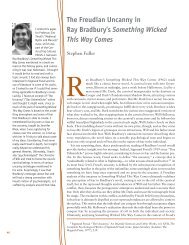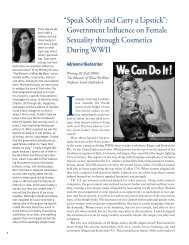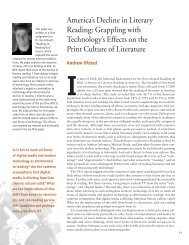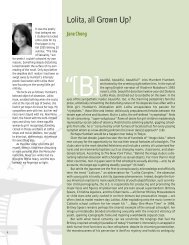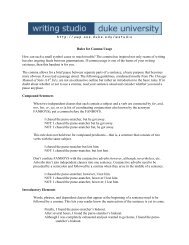Painted Nails and Personal Narratives - Thompson Writing Program
Painted Nails and Personal Narratives - Thompson Writing Program
Painted Nails and Personal Narratives - Thompson Writing Program
Create successful ePaper yourself
Turn your PDF publications into a flip-book with our unique Google optimized e-Paper software.
ecome automatically activated (Abraham 4).<br />
Simply put, the individual in the story seems<br />
real because she reminds one of oneself. If this<br />
merging of the self-<strong>and</strong>-other sounds distinctly<br />
like Dr. Schafer’s definition of empathy —<br />
that of “feel[ing] yourself into the subjective<br />
experience of another” — that’s because it is;<br />
hearing about real people causes us to see<br />
them as more relevant to ourselves. Their ex -<br />
periences bring to mind our experiences, <strong>and</strong><br />
together, identities intertwine. Thus, reading<br />
creative nonfiction allows a physician to practice<br />
relating foreign experiences to personal<br />
ones; it nurtures a habit of seeing the world<br />
through another’s eyes <strong>and</strong> encourages exactly<br />
the sort of empathy hospital wards need.<br />
The ability to empathize, however, is not<br />
the only otherwise elusive skill that creative<br />
nonfiction nurtures. Reading personal writing<br />
also teaches aspiring doctors what we all<br />
failed to learn in kindergarten: how to listen.<br />
According to Dr. J. Vannatta of the University<br />
of Oklahoma, doctors can find about eighty<br />
to eighty-five percent of the information necessary<br />
for diagnosis in patient narratives (qtd.<br />
in Smith 55). Yet the medical interview often<br />
acts as an interrogation; the doctor fires off a<br />
list of questions about cough frequency, sleep<br />
fluctuations <strong>and</strong> the intensity of a running<br />
nose on a scale from one to ten. Although<br />
such rapid-fire run-downs may diagnose common<br />
conditions, Dr. Rita Charon argues that<br />
more complicated conditions require a patient<br />
to tell his story in full. As Charon listens, she<br />
must “identify metaphors or images, tolerate<br />
ambiguity <strong>and</strong> uncertainty…identify the<br />
unspoken subtexts, <strong>and</strong> hear one story in light<br />
of others told by [the] teller” (Charon 4). The<br />
doctor must remain sensitive to nuances of<br />
the patient’s story that no check-mark list can<br />
capture. This sort of intense attention may<br />
sound superhuman, but quite frankly, it<br />
isn’t — English professors have taught it for<br />
years. The art of interpretation lies in the<br />
domain of literary scholars, but such exclusivity<br />
need not be the case. Charon argues that<br />
such “narrative knowledge” finds apt application<br />
in healthcare, for doctors exposed to the<br />
literary arts cultivate skills of careful reading<br />
that translate into skills of careful listening<br />
(10). Readers cannot interrupt an author in<br />
the midst of her essay, <strong>and</strong> a doctor cannot<br />
interject to ask if the pain was mild, moderate,<br />
or intense. Instead, the listener, like the<br />
reader, must wait, collect evidence, <strong>and</strong> un -<br />
derst<strong>and</strong> the patient’s story from the patient’s<br />
viewpoint, not her own.<br />
What does this sort of interaction look<br />
like? It’s not a specialized set of knowledge or<br />
a radically new mode of treatment—it’s a subtle<br />
kind of attention to detail that we already<br />
practice when we open a book. The difference,<br />
though, is that instead of reading an essay,<br />
we’re reading a patient. Dr. Charon tells us<br />
the story of a man who came into her office<br />
complaining of crippling abdominal cramps.<br />
Charon, however, looked beyond the textbook<br />
list of ailments. She noted the pressured way<br />
her patient spoke, saw the tension with which<br />
he gripped the examination table, <strong>and</strong> remembered<br />
his words when he said that he had<br />
endured the pain for a decade or so without<br />
once stepping into a hospital. These small<br />
signs signaled to Charon that her pa tient harbored<br />
a long-st<strong>and</strong>ing fear of the medical<br />
Hearing about real<br />
people causes us to see<br />
them as more relevant<br />
to ourselves.<br />
establishment—one that had compromised his<br />
health for years. With this knowledge in mind,<br />
she treated him with extra gentleness to ensure<br />
that her examination was “not an assault but<br />
an effort to help” (Charon 12). This is what listening<br />
to the patient means; by absorbing the<br />
man as a person with a past rather than as a<br />
hodgepodge of symptoms, she cared for his<br />
health—not only as it pertained to his immediate<br />
condition, but also as it related to his relationship<br />
with medicine as a whole.<br />
Careful listening, however, requires even<br />
more than picking up details <strong>and</strong> piecing<br />
57



